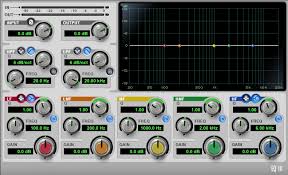
Dyn3 7-band EQ (Avid Pro Tools free plugin)
If you look toward the bottom of the EQ pictured above, you will notice 5 different bands: 1. LF, low frequency, red; 2. LMF, low-mid frequency, orange; 3. MF, mid frequency, yellow; 4. HMF, high-mid frequency, green; 5. HF, high frequency, blue.
In today’s blog I will talk about these five bands. I want to start with band 1 and 5. These are typically used and referred to as “shelves.” Band 1, low frequencies, is the low shelf, and band 5, high frequencies, is the high shelf.
But these two bands each have two different settings. The small left icon, next to the LF and HF, is called a bell-type EQ. It kind of looks like -o-. This will either boost or cut a section of frequencies set by you with the frequency knob. The ‘Q’ knob will determine how wide or narrow the bell curve will be. A low Q setting will give you a wide band of frequencies, and a high Q will render a narrow band of frequencies. A good rule of thumb is wide when boosting and narrow when cutting.
The typical use for this is to, say, boost the lower frequencies to bring out a kick drum or synth bass. On the high end, with the HF knob, we can boost upper ‘air’ frequencies to make guitars or vocals stand out or sound brighter. Of course, we can also cut in these frequency ranges as well.
The other icon setting is called a ‘shelf.’ This is the more common use for these two bands. Typically we use a boost here (low or high). When boosted, it looks just like a “shelf.” If on the low shelf, we set the frequency knob to 125 Hz, then everything from 125 on down (to 20 Hz) is boosted the same amount. On the high shelf, we might add a shelf for vocals starting at 6 kHz. In this case everything from 6 k up will have a boost. Of course, we can also cut using a shelf, but this happens less often then a boost.
The Q factor is a bit more complicated and will have to be reserved for another post.
Bands 2, 3 and 4 allow for bell curve settings only. These are the same as the bell curves on bands 1 and 5. These are used for low-mid, mid, and high-mid frequencies. There are only three knobs: Frequency, Gain and Q. Frequency, of course, sets the frequency that you want to work with. Gain is volume (loudness) and can be plus (positive) or minus (negative). We might say boost 2 kHz 2 dB (2 dB) which is a positive gain. Or cut 1200 Hz 3 dB (-3 dB) which would be a negative gain.
As stated above, Q determines the amount of frequencies being altered by the EQ.
As always, I hope this helps!
And, HEY! Make it a Great day!
Tim

